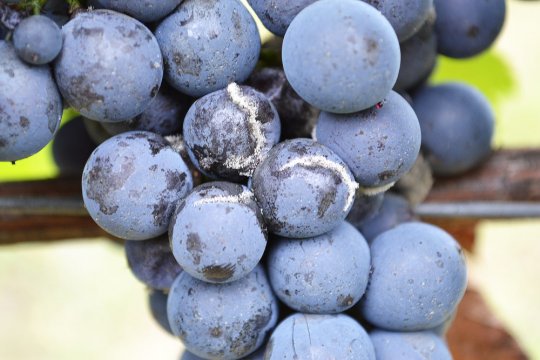Grey rot (Botrytis cinerea) is a disease that has been known to winegrowers since antiquity. The fungus responsible, whose perfect form (Botryotinia fuckeliana) is rarely found, is a saprophyte that can develop very quickly, taking advantage of the slightest wound to establish itself.
2.4.1.d Botrytis cinerea
What are the symptoms of Botrytis on leaves?
Spring outbreaks appear as brown spots with a greyish felting on the underside (the fungus' fruiting bodies). These spots first form a triangle starting from the edge of the leaf and then tend to increase and invade the entire leaf.
What are the symptoms of Botrytis on vine shoots?
Shoots are usually parasitized as a result of wounds. The shoots turn brown before they lignify. Following hardening (lignification), they turn white and black blisters appear called sclerotia.
What are Botrytis cinerea symptoms on bunches?
Clusters may be affected prior to flowering and dry out. However, they are most vulnerable around véraison. At this stage, the characteristic symptoms are:
-
A brown colouration of the berries for white grape varieties
-
Appearance of a thick grey felting on the berries
-
After véraison, if the weather is sufficiently humid, grey rot can contaminate the entire bunch.
What is the biology of the fungus?
Sclerotia, carried by fallen leaves or affected shoots, are storage organs for the fungus formed by mycelial aggregation. Mycelia can also survive the winter. They are then found under the bark and act as saprophytes. During the spring, the mycelia and sclerotia produce conidia.
The organs are then spread by the wind and penetrate the herbaceous organs directly or via wounds. From being saprophytic, the fungus becomes a parasite. The conidia then progress through the organs causing their necrosis. Below 13°C, the progression of Botrytis is almost non-existent, however, when the temperature is around 25°C, progression is very rapid. High humidity is sufficient to ensure progression and contaminations.
Two situations can occur during Botrytis's development:
-
The berries are not receptive: in which case, contaminations can still occur through wounds (floral abscission) but the parasite remains latent until the berries become receptive.
-
The berries are receptive: in this case contaminations occur either through wounds by conidia; or the mycelia contaminate the berry by breaking down its skin.
Rot development is carried out by mycelia while the appearance of new outbreaks are caused by conidia.
Extracts from Vigne Vin Occitanie.
Can these symptoms be easily confused with another disease?
Botrytis, or grey rot, can have similar symptoms to those of black rot on leaves, i.e. the formation of brown spots. However, these spots are larger, begin at the edge of the leaf, and have grey felting on the underside, which is not the case with black rot. Symptoms on Leaves are often less common than symptoms on bunches. It is easily recognizable on bunches with the appearance of a brown colouration on white grapes and the formation of "veins" of white/grey felting, which is a fairly clear indicator of this disease. There is therefore little risk of confusion with another disease and its identification is thus relatively straightforward. Moreover, vines are most sensitive to this disease around véraison, while other diseases generally occur earlier in the season.
What practices encourage Botrytis cinerea development? What preventive measures are there?
-
Plant material selection: Certain grape varieties are more susceptible than others to this fungus, such as Sauvignon Blanc, Merlot and Semillon. Grape varieties with compact bunches are more likely to be contaminated. Prophylactic solutions: Rootstock choice must be adapted to the grape variety and the characteristics of the plot to limit the vines' vigour and the accumulation of vegetation that can increase the risk of Botrytis contamination. Grape varieties with less sensitivity to Botrytis can also be favoured, such as Carignan.
-
Vineyard management: high humidity and temperatures around 25°C, when combined, are sufficient to ensure the fungus' development and result in contamination. The microclimate around bunches can easily provide such conditions when the vines are dense, vigorous and have a high load. Prophylactic solutions: adopt growing methods that favour adequate ventilation of the bunches, i.e. green operations such as debudding, leaf thinning in the fruit-bearing zone, and thinning of groups of bunches are all elements that help reduce the risk of Botrytis attacks.
-
Vigour management: excessive fertilization or nitrogenous inputs can accentuate factors contributing to Botrytis contamination, as can overly competitive grass cover. Prophylactic solutions: adapt the plant material to the plot's characteristics as well as any fertilization programmes.
-
Parasite management: the proliferation of parasites such as the Eudemis and Cochylis moths, which are vectors of Botrytis, particularly in the second and third generations, favours presence of the fungus. Prophylactic solutions: mating disruption can reduce the risk of proliferation of moths.
-
Alternative prophylactic methods: chitosan has the ability to stimulate the vine's natural defences, it encourages the fruit's own resistance but does not directly inhibit the fungus. Some bacillus bacteria combat Botrytis through competition for space and nutrients (nitrogen), since the fungus is particularly sensitive to a lack of nutrients.
What treatments exist to prevent this fungus?
Besides the fungicides specific to the parasite that are prohibited in organic agriculture, there are anti-mildew treatments that slow down the development of Botrytis as a secondary effect.
At what stage of the vines' development should treatment be started?
There are four key periods for preventive treatments:
- End of flowering/flower cap fall or stage A
- Closing of bunches or stage B
- Beginning of véraison or stage C
- Three weeks prior to harvest or stage D, the concern with this last treatment being the amount of time until harvest.
Extract from Vigne Vin Occitanie


